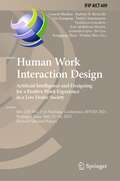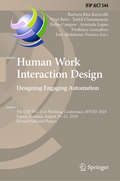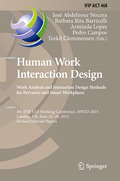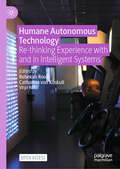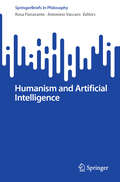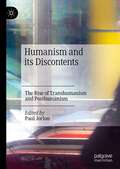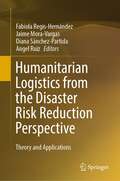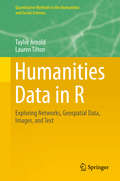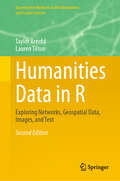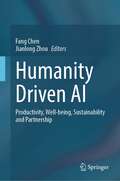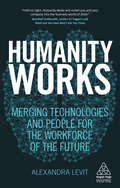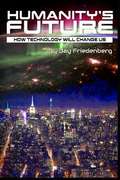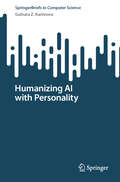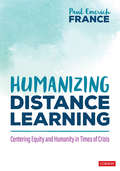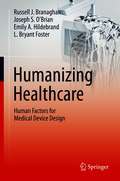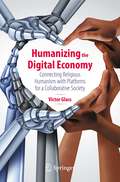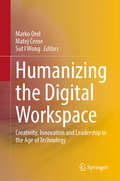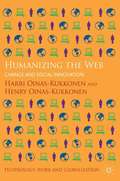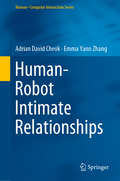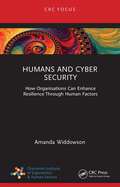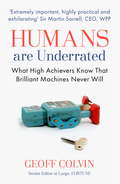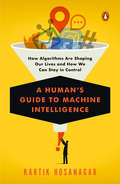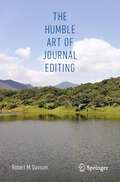- Table View
- List View
Human Work Interaction Design. Artificial Intelligence and Designing for a Positive Work Experience in a Low Desire Society: 6th IFIP WG 13.6 Working Conference, HWID 2021, Beijing, China, May 15–16, 2021, Revised Selected Papers (IFIP Advances in Information and Communication Technology #609)
by Arminda Lopes Torkil Clemmensen José Abdelnour-Nocera Frederica Gonçalves Ganesh Bhutkar Barbara R. Barricelli Qin Xiangang Fei Lyu Ronggang Zhou Wenjun HouThis book constitutes the thoroughly refereed post-conference proceedings of the 6th IFIP WG 13.6 Working Conference on Human Work Interaction Design, HWID 2021, held in Beijing, China, in May, 2021. The 10 revised and extended full papers presented were carefully selected for inclusion in this volume. The papers deal with the analysis and interaction design of a variety of complex work and life contexts found in different business and application domains. They focus on interaction design for work engagement taking usability of interactive systems to the next level by providing employees pleasurable and meaningful experiences via the tools used at work. The papers are organized the following topical sub-headings: Trends in human Work Interaction Design; Workplace & work experience Analysis for Interaction Design; and Artificial Intelligence (AI) for Human Work.
Human Work Interaction Design. Designing Engaging Automation: 5th IFIP WG 13.6 Working Conference, HWID 2018, Espoo, Finland, August 20 - 21, 2018, Revised Selected Papers (IFIP Advances in Information and Communication Technology #544)
by Barbara Rita Barricelli Virpi Roto Torkil Clemmensen Pedro Campos Arminda Lopes Frederica Gonçalves José Abdelnour-NoceraThis book constitutes the thoroughly refereed post-conference proceedings of the 5th IFIP WG 13.6 Working Conference on Human Work Interaction Design, HWID 2018, held in Espoo, Finland, in August 2018.The 19 revised and extended full papers presented were carefully selected for inclusion in this volume. The papers deal with the analysis and interaction design of a variety of complex work and life contexts found in different business and application domains. They focus on interaction design for work engagement taking usability of interactive systems to the next level by providing employees pleasurable and meaningful experiences via the tools used at work. The papers are organized in two sections: the first section presents cases of HWID in practice, while the second one focuses on methodological discussion.
Human Work Interaction Design. Work Analysis and Interaction Design Methods for Pervasive and Smart Workplaces
by José Abdelnour Nocera Barbara Rita Barricelli Arminda Lopes Pedro Campos Torkil ClemmensenThis book constitutes the thoroughly refereed post-conference proceedings of the 4th IFIP WG 13. 6 Working Conference on Human Work Interaction Design, HWID 2015, held in London, UK, in June 2015. The 15 revised full papers presented were carefully selected for inclusion in this volume. The papers reflect many different areas and address many complex and diverse work domains, focusing on the integration of work analysis and interaction design methods for pervasive and smart workplaces. They are organized in the following sections: methodologies; environment, and specific contexts.
Humane Autonomous Technology: Re-thinking Experience with and in Intelligent Systems
by Rebekah Rousi Catharina Von Koskull Virpi RotoThis open access book takes a human-focused multidisciplinary look at the ways in which autonomous technology shapes experience, affecting human lives and ways of working in settings ranging from the arts, design, and service to maritime and industry. The book focuses on the humane, observing how technology can be designed and implemented in an ethical, human-centered way. Chapters in this book highlight factors that impinge on the humane and ethical, such as challenging questions of intellectual property rights, roles of humans, biases, and the uptake of other deviant human traits. Through delving into a range of dimensions and contexts from culture, the arts and design, to service, heavy industry and maritime, the contributors demonstrate that artificial intelligence and its related autonomous systems need to be understood holistically, as a system of systems, that should be working for the benefit of human present and future.
Humanism and Artificial Intelligence (SpringerBriefs in Philosophy)
by Antonino Vaccaro Rosa FioravanteThis book contributes to the debate on humanism in AI by providing a, so far lacking, comprehensive account of the significant challenges posed by AI to organizations from a humanistic perspective. It does so in two ways: by discussing ethical challenges of AI using humanistic assumptions, normative implications, and underpinning theoretical stances and by focusing on those challenges that can be considered well suited to be tackled from a humanistic perspective as they are more urgent for humanistic-led organizations, as well as those willing to become so. This new perspective allows for new and important discussions, making the book an important read for philosophers of technology and AI.
Humanism and its Discontents: The Rise of Transhumanism and Posthumanism
by Paul JorionThis book explains that while posthumanism rose in opposition to the biblical contention that ‘Man was created in the image of God’, transhumanism ascertained the complementary view that ‘Man has been assigned dominion over all creatures’, further exploring a path that had been opened up by the Enlightenment’s notion of human perfectibility.It explains also how posthumanism and transhumanism relate to deconstruction theory, and on a broader level to capitalism, libertarianism, and the fight against human extinction which may involve trespassing the boundary of the skin, achieving individual immortality or dematerialization of the Self and colonisation of distant planets and stars.Two authors debate about truth and reason in today’s world, the notion of personhood and the legacy of the Nietzschean Superhuman in the current varieties of anti-humanism.
Humanitarian Logistics from the Disaster Risk Reduction Perspective: Theory and Applications
by Angel Ruiz Diana Sánchez-Partida Fabiola Regis-Hernández Jaime Mora-VargasThis book aims to clarify the priorities of the Sendai Framework for the DRR 2015 – 2030, through gathering recent contributions addressing the different ways researchers define, measure, reduce, and manage risk in the challenge of the DRR. Beyond a discussion of the different definitions of disaster risk; this book provides contributions focused on optimization approaches that support the decision-making process in the challenge of managing DRR problems considering emerging disaster risks in the medium and long term, as well as national and local applications. Some of the topics covered include network flow problems, stochastic optimization, discrete optimization, multi-objective programming, approximation techniques, and heuristic approaches.The target audience of the book includes professionals who work in Linear Programming, Logistics, Optimization (Mathematical, Robust, Stochastic), Management Science, Mathematical Programming, Networks, Scheduling, Simulation, Supply Chain Management, Sustainability, and similar areas. It can be useful for researchers, academics, graduate students, and anyone else doing research in the field
Humanities Data in R
by Taylor Arnold Lauren TiltonThis pioneering book teaches readers to use R within four core analytical areas applicable to the Humanities: networks, text, geospatial data, and images. This book is also designed to be a bridge: between quantitative and qualitative methods, individual and collaborative work, and the humanities and social sciences. Humanities Data with R does not presuppose background programming experience. Early chapters take readers from R set-up to exploratory data analysis (continuous and categorical data, multivariate analysis, and advanced graphics with emphasis on aesthetics and facility). Following this, networks, geospatial data, image data, natural language processing and text analysis each have a dedicated chapter. Each chapter is grounded in examples to move readers beyond the intimidation of adding new tools to their research. Everything is hands-on: networks are explained using U. S. Supreme Court opinions, and low-level NLP methods are applied to short stories by Sir Arthur Conan Doyle. After working through these examples with the provided data, code and book website, readers are prepared to apply new methods to their own work. The open source R programming language, with its myriad packages and popularity within the sciences and social sciences, is particularly well-suited to working with humanities data. R packages are also highlighted in an appendix. This book uses an expanded conception of the forms data may take and the information it represents. The methodology will have wide application in classrooms and self-study for the humanities, but also for use in linguistics, anthropology, and political science. Outside the classroom, this intersection of humanities and computing is particularly relevant for research and new modes of dissemination across archives, museums and libraries.
Humanities Data in R: Exploring Networks, Geospatial Data, Images, and Text (Quantitative Methods in the Humanities and Social Sciences)
by Taylor Arnold Lauren TiltonThis book teaches readers to integrate data analysis techniques into humanities research practices using the R programming language. Methods for general-purpose visualization and analysis are introduced first, followed by domain-specific techniques for working with networks, text, geospatial data, temporal data, and images. The book is designed to be a bridge between quantitative and qualitative methods, individual and collaborative work, and the humanities and social sciences. The second edition of the text is a significant revision, with almost every aspect of the text rewritten in some way. The most notable difference is the incorporation of new R packages such as ggplot2 and dplyr that center broad data-science concepts. This 2nd edition of Humanities Data with R does not presuppose background programming experience. Early chapters take readers from R set-up to exploratory data analysis, with one chapter dedicated to each stage of the data-science pipeline (data collection, visualization, manipulation, and relational joins). Following this, text analysis, networks, temporal data, geospatial data, and image analysis each have a dedicated chapter. These are grounded in examples to move readers beyond the intimidation of adding new tools to their research. The final section of the book extends the core material with additional computer science techniques for processing large datasets. Everything is hands-on: image analysis is explained using digitized photographs from the 1930s, and networks are applied to page links on Wikipedia. After working through these examples with the provided data, code and book website, readers are prepared to apply new methods to their own work. The open source R programming language, with its myriad packages and popularity within the sciences and social sciences, is particularly well-suited to working with humanities data. R packages are also highlighted in an appendix. The methodology will have wide application in classrooms and self-study for the humanities, but also for use in linguistics, anthropology, and political science. Outside the classroom, this intersection of humanities and computing is particularly relevant for research and new modes of dissemination across archives, museums and libraries.
Humanity Driven AI: Productivity, Well-being, Sustainability and Partnership
by Fang Chen Jianlong ZhouArtificial Intelligence (AI) is changing the world around us, and it is changing the way people are living, working, and entertaining. As a result, demands for understanding how AI functions to achieve and enhance human goals from basic needs to high level well-being (whilst maintaining human health) are increasing. This edited book systematically investigates how AI facilitates enhancing human needs in the digital age, and reports on the state-of-the-art advances in theories, techniques, and applications of humanity driven AI. Consisting of five parts, it covers the fundamentals of AI and humanity, AI for productivity, AI for well-being, AI for sustainability, and human-AI partnership. Humanity Driven AI creates an important opportunity to not only promote AI techniques from a humanity perspective, but also to invent novel AI applications to benefit humanity. It aims to serve as the dedicated source for the theories, methodologies, and applications on humanity driven AI, establishing state-of-the-art research, and providing a ground-breaking book for graduate students, research professionals, and AI practitioners.
Humanity Works: Merging Technologies and People for the Workforce of the Future (Kogan Page Inspire)
by Alexandra LevitThe professional landscape is transforming, and the only way to maintain competitive advantage is to maximize the unique skills of your workforce. In Humanity Works, bestselling author, global workplace consultant and futurist Alexandra Levit provides a guide to making the most of the human traits of creativity, judgement, problem solving and interpersonal sensitivity. Revealing what the 'robot takeover' will really look like, how talent and machines can work side by side and how you can make organizational structures more agile and innovation focused, this book will prepare you to lead organizations of the future.Humanity Works doesn't just explain the fascinating trends of the future of work; it condenses cutting-edge academic and business thinking to show what you can do about the future right now. Original, real-life case studies including Nestle, The Washington Post, Deloitte, and Pepsi combined with exercises and workplace tools will equip you for staying innovative and successful in the wake of major workplace disruption. Everything hinges on capturing the human edge in your organization.
Humanity's Future: How Technology Will Change Us
by Jay Friedenberg[from the back cover] "Humanity's Future examines the psychological and social impact or likely Future events related to advanced technology. Will humanity Feel useless in a Future where most tasks are automated and robots do all the work? Will society experience alienation and angst, collapsing into a state of decadence and corruption? How might we improve ourselves, as technology advances in unprecedented ways? Who gets to decide? Can we advance civilization and eliminate genocide and war? Philosophical, scientific and pragmatic issues intertwine complexly here, and uncertainties abound, but Dr. Friedenberg unravels the various possibilities with a masterful clarity."
Humanizing AI with Personality (SpringerBriefs in Computer Science)
by Gulnara Z. KarimovaHumanizing AI with Personality examines artificial intelligence from ethical, business, and technical perspectives, offering a preliminary yet comprehensive guide for decision-makers interested in integrating conversational agents with distinct personalities. This book provides an understanding of the key factors for crafting AI systems imbued with human-like attributes, equipping them to engage thoughtfully with the varied demands of organizational contexts and societal expectations. By addressing the ethical challenges, technical approaches, and practical considerations associated with implementing AI with personality, this book serves as an essential resource for those seeking to understand the multiple dimensions involved.
Humanizing Distance Learning: Centering Equity and Humanity in Times of Crisis
by Paul Emerich France"In some ways, shouldn′t we always be teaching from a distance?" Paul France asks this not as pitch for distance learning. But because part of the reason distance learning has been so challenging, Paul asserts, is that we’re replicating long-standing practices that promote dependent learning in our students. Why not use this unique moment of time to reconnect with the true purpose of teaching: to help our students become liberated learners and free thinkers? The next logical step in teachers’ months-long distance learning "journey," Humanizing Distance Learning describes how to center humanity and equity in our process of reimagining learning. Even while teaching and learning miles apart through screens, you’ll discover how to Build independence within your students so they’re better equipped to tackle challenges with persistence and learn how to learn Make collaboration and human connection essential components of your pedagogy, offering students the chance to socialize and learn from one another Center and unpack students’ identities, helping them develop a conscious knowledge of themselves, all the while using their self-identified strengths to overcome any obstacles Plan, prepare, and implement humanized instruction while teaching for student liberation—both digitally and in person. Investigate technology integration, including the Digital Divide, as well as ways to minimize EdTech integration so that our collective sense of humanity can continue to be front and center "The future," Paul writes, "may be unclear, the road may be rocky, and the story may continue to be long and winding as we push forward through this global crisis. But the answer will always be simple: We must teach and learn in pursuit of a deeper sense of collective humanity—and for no other reason." "This book is equal parts visionary and practical, courageous and invitational. It addresses foundational needs and wrenching challenges teachers faced during the recent time when U.S. teachers abruptly found themselves teaching remotely. . . . It is a deeply humanizing book." ~Carol Ann Tomlinson, William Clay Parrish, Jr. Professor Emeritus, University of Virginia "Humanizing Distance Learning is a book for our times not only because it addresses how to build a culture of thinking and teach for understanding at a distance, but also because it challenges the status quo of education by offering a more liberated and humane vision." ~Ron Ritchhart, Senior Research Associate, Harvard Graduate School of Education "Paul France has produced a timely and necessary book that will help educators humanize distance learning. Recognizing incredible dimensions of complexity, this book will surely help educators traverse times of uncertainty in distance learning."</spa
Humanizing Distance Learning: Centering Equity and Humanity in Times of Crisis
by Paul Emerich France"In some ways, shouldn′t we always be teaching from a distance?" Paul France asks this not as pitch for distance learning. But because part of the reason distance learning has been so challenging, Paul asserts, is that we’re replicating long-standing practices that promote dependent learning in our students. Why not use this unique moment of time to reconnect with the true purpose of teaching: to help our students become liberated learners and free thinkers? The next logical step in teachers’ months-long distance learning "journey," Humanizing Distance Learning describes how to center humanity and equity in our process of reimagining learning. Even while teaching and learning miles apart through screens, you’ll discover how to Build independence within your students so they’re better equipped to tackle challenges with persistence and learn how to learn Make collaboration and human connection essential components of your pedagogy, offering students the chance to socialize and learn from one another Center and unpack students’ identities, helping them develop a conscious knowledge of themselves, all the while using their self-identified strengths to overcome any obstacles Plan, prepare, and implement humanized instruction while teaching for student liberation—both digitally and in person. Investigate technology integration, including the Digital Divide, as well as ways to minimize EdTech integration so that our collective sense of humanity can continue to be front and center "The future," Paul writes, "may be unclear, the road may be rocky, and the story may continue to be long and winding as we push forward through this global crisis. But the answer will always be simple: We must teach and learn in pursuit of a deeper sense of collective humanity—and for no other reason." "This book is equal parts visionary and practical, courageous and invitational. It addresses foundational needs and wrenching challenges teachers faced during the recent time when U.S. teachers abruptly found themselves teaching remotely. . . . It is a deeply humanizing book." ~Carol Ann Tomlinson, William Clay Parrish, Jr. Professor Emeritus, University of Virginia "Humanizing Distance Learning is a book for our times not only because it addresses how to build a culture of thinking and teach for understanding at a distance, but also because it challenges the status quo of education by offering a more liberated and humane vision." ~Ron Ritchhart, Senior Research Associate, Harvard Graduate School of Education "Paul France has produced a timely and necessary book that will help educators humanize distance learning. Recognizing incredible dimensions of complexity, this book will surely help educators traverse times of uncertainty in distance learning."</spa
Humanizing Healthcare – Human Factors for Medical Device Design
by Russell J. Branaghan Joseph S. O’Brian Emily A. Hildebrand L. Bryant FosterThis book introduces human factors engineering (HFE) principles, guidelines, and design methods for medical device design. It starts with an overview of physical, perceptual, and cognitive abilities and limitations, and their implications for design. This analysis produces a set of human factors principles that can be applied across many design challenges, which are then applied to guidelines for designing input controls, visual displays, auditory displays (alerts, alarms, warnings), and human-computer interaction. Specific challenges and solutions for various medical device domains, such as robotic surgery, laparoscopic surgery, artificial organs, wearables, continuous glucose monitors and insulin pumps, and reprocessing, are discussed. Human factors research and design methods are provided and integrated into a human factors design lifecycle, and a discussion of regulatory requirements and procedures is provided, including guidance on what human factors activities should be conducted when and how they should be documented.This hands-on professional reference is an essential introduction and resource for students and practitioners in HFE, biomedical engineering, industrial design, graphic design, user-experience design, quality engineering, product management, and regulatory affairs.Teaches readers to design medical devices that are safer, more effective, and less error prone;Explains the role and responsibilities of regulatory agencies in medical device design;Introduces analysis and research methods such as UFMEA, task analysis, heuristic evaluation, and usability testing.
Humanizing the Digital Economy: Connecting Religious Humanism with Platforms for a Collaborative Society
by Victor GlassThe Coding Revolution—a combination of the Digital Revolution and genetic engineering—has had a destructive effect on society. It has created a platform for extreme views that is loosening our economic, cultural, and political moorings. This book provides a systematic approach to policy and management to promote societal collaboration and unity. It describes the changes caused by the Digital Age, including the Internet, Artificial Intelligence, and various other technologies. The author then offers a new framework, Religious Humanism, which incorporates covenants of the Bible, the US Constitution and other sources of wisdom to foster collaboration and create a revitalized and inclusive global society. Narrative and analytical tools are offered as well as case examples.
Humanizing the Digital Workspace: Creativity, Innovation and Leadership in the Age of Technology
by Marko Orel Matej Černe Sut I WongThe digital economy has fundamentally transformed how we live and work, bringing opportunities and challenges. One of the key challenges is understanding how to effectively navigate the relationship between people and technology and harness its power to foster creativity, innovation, and digital leadership. This book examines the relationship between people and technology in the digital workspace from a multidisciplinary perspective. Unlike most of the existing literature which focuses on the technological aspects of digitization in the workplace, this book equally considers the psychological, social, and cultural implications as well. The contributing authors also provide insights on employee well-being, motivation, and engagement and challenge the assumption that digital technology stifle creativity by demonstrating how innovation can foster collaboration, experimentation, and risk-taking. Featuring research, theories, case studies, surveys, and interviews from fields such as sociology, psychology and management, this book is of interest to scholars, researchers, and students in sociology, psychology, management and related disciplines, as well as professionals and leaders looking to better understand the impact of technology on the modern workplace.
Humanizing the Web
by Harri Oinas-Kukkonen Henry Oinas-KukkonenOffers a vivid description of the ongoing transformation of the web into something that is widely recognized and that will have an enormous impact on how people work and live their lives in the future. Presents concepts that will help readers understand why the web evolved as it did, what is going on right now, and what will happen next.
Human–Robot Intimate Relationships (Human–Computer Interaction Series)
by Adrian David Cheok Emma Yann ZhangThe idea of humans falling in love with artificial beings is not a modern conception. Our relationship with artificial partners has come a long way since Pygmalion and his ivory lover. In recent years, there has been a strong upsurge of interest and discussions in the various aspects of intimate relationships between humans and artificial partners. This interest is evidenced by the increase in media coverage, TV documentaries and films on this topic, as well as the active research efforts within the academic community. This book provides a comprehensive collection and overview of the latest development in the field of intimate relationships between humans and artificial partners, in particular robots and virtual agents. It includes relevant research work undertaken by the authors, the latest advancements in technology and commercial products, and future predictions and insights from leading experts in the area. This book contains an in-depth discussion of the engineering, philosophical, psychological, ethical, and sociological implications of relationships with artificial companions. It also gives a glimpse of some future directions of artificial intelligence, human-computer love and sexual interaction, robotics engineering etc. It is a great resource for researchers and professionals working in these areas. The narrative style of the book also makes it an enjoyable and educational read for everyone.
Humans and Cyber Security: How Organisations Can Enhance Resilience Through Human Factors
by Amanda WiddowsonCyber security incidents are often attributed to “human error”. The discipline of human factors recognises the importance of identifying organisational root causes, rather than focusing on individual actions or behaviours. Humans and Cyber Security: How Organisations Can Enhance Resilience Through Human Factors delivers an applied approach to capturing and mitigating the risk of the human element in cyber security and proposes that it is easier to change organisational practices than it is individual behaviour.This book identifies undesirable behaviours and practices, then analyses why they occur, and finally, offers mitigating actions. Models of behavioural motivations will be discussed alongside individual vulnerabilities. Organisational vulnerabilities will form the main focus of an applied approach to capturing and mitigating the risk of the human element in cyber security. It concludes with recommended processes that involve talking to a range of individuals across the organization. Backed up with practical materials to facilitate data collection, applied examples and mitigating strategies to address known human vulnerabilities, this book offers the reader a complete view of understanding and preventing cyber security breaches.The solutions in this book will appeal to students and professionals of human factors, security, informational technology, human resources and business management.
Humans Are Underrated: What High Achievers Know that Brilliant Machines Never Will
by Geoff ColvinIn the dawning age of brilliant machines, what will people do better than computers?It's easy to imagine a frightening future in which technology takes over the jobs that we now get paid to do, working more accurately and for barely any cost. Computers can already perform surgery, drive vehicles, write articles and do intricate legal work, so what hope will there be for tomorrow's workforce?Drawing on a wealth of research, Geoff Colvin uncovers the skills that will be in great demand as technology advances - and how they can be developed. In this new machine age, we shouldn't try to beat computers at what they can do. We'll lose that contest. Instead we must look to unlikely places, learn from the best, and cultivate the human abilities that make us unique.
A Human's Guide to Machine Intelligence: How Algorithms Are Shaping Our Lives and How We Can Stay in Control
by Kartik HosanagarA Wharton professor and tech entrepreneur examines how algorithms and artificial intelligence are starting to run every aspect of our lives, and how we can shape the way they impact usThrough the technology embedded in almost every major tech platform and every web-enabled device, algorithms and the artificial intelligence that underlies them make a staggering number of everyday decisions for us, from what products we buy, to where we decide to eat, to how we consume our news, to whom we date, and how we find a job. We've even delegated life-and-death decisions to algorithms--decisions once made by doctors, pilots, and judges. In his new book, Kartik Hosanagar surveys the brave new world of algorithmic decision-making and reveals the potentially dangerous biases they can give rise to as they increasingly run our lives. He makes the compelling case that we need to arm ourselves with a better, deeper, more nuanced understanding of the phenomenon of algorithmic thinking. And he gives us a route in, pointing out that algorithms often think a lot like their creators--that is, like you and me.Hosanagar draws on his experiences designing algorithms professionally--as well as on history, computer science, and psychology--to explore how algorithms work and why they occasionally go rogue, what drives our trust in them, and the many ramifications of algorithmic decision-making. He examines episodes like Microsoft's chatbot Tay, which was designed to converse on social media like a teenage girl, but instead turned sexist and racist; the fatal accidents of self-driving cars; and even our own common, and often frustrating, experiences on services like Netflix and Amazon. A Human's Guide to Machine Intelligence is an entertaining and provocative look at one of the most important developments of our time and a practical user's guide to this first wave of practical artificial intelligence.
Humans Need Not Apply: A Guide to Wealth & Work in the Age of Artificial Intelligence
by Jerry KaplanAn &“intriguing, insightful&” look at how algorithms and robots could lead to social unrest—and how to avoid it (The Economist, Books of the Year). After decades of effort, researchers are finally cracking the code on artificial intelligence. Society stands on the cusp of unprecedented change, driven by advances in robotics, machine learning, and perception powering systems that rival or exceed human capabilities. Driverless cars, robotic helpers, and intelligent agents that promote our interests have the potential to usher in a new age of affluence and leisure—but as AI expert and Silicon Valley entrepreneur Jerry Kaplan warns, the transition may be protracted and brutal unless we address the two great scourges of the modern developed world: volatile labor markets and income inequality. In Humans Need Not Apply, he proposes innovative, free-market adjustments to our economic system and social policies to avoid an extended period of social turmoil. His timely and accessible analysis of the promises and perils of AI is a must-read for business leaders and policy makers on both sides of the aisle. &“A reminder that AI systems don&’t need red laser eyes to be dangerous.&”—Times Higher Education Supplement &“Kaplan…sidesteps the usual arguments of techno-optimism and dystopia, preferring to go for pragmatic solutions to a shrinking pool of jobs.&”—Financial Times
The Humble Art of Journal Editing
by Robert M. DavisonThe publication of scholarly research is both a major driver of social progress and a significant industry in its own right. Scholarly research is the focus of attention for countless numbers of scholars globally and a key measure of scholarly excellence. Much has been written about the conduct of research that is designed to help scholars attain appropriate standards of rigor and relevance, and indeed craft their research outputs in ways appropriate for different venues, notably as journal articles, conference papers, book chapters, and books. However, although scholarly researchers fulfill roles other than as authors, for instance as journal reviewers and editors, there is a dearth of consolidated information about the nature of editorial work. Drawing on over two decades of experience in editing scholarly journals, the author offers a more systematic guide to scholarly journal editing.The book begins with an introduction to the art of scholarly journal editing,the nature of that art (Chapter 1), and an examination of editorial promulgation of cultural values of scholarly journals with an emphasis on responsible research (Chapter 2). Chapter 3 examines the many issues associated with sourcing content, and opines on the novelty, breadth, and depth of research, including discussions of indigenous theorization, serendipity, iconoclastic research, and the value of special issues. Chapter 4 deals with the review process and offers advice for formulating effective reviewer guidelines that lead to constructive and developmental advice for authors. The next two chapters discuss the audience of the journal as well as publisher relations. Finally, the book is concluded with thoughts and recommendations about emerging challenges, such as the ethics of AI tools (like ChatGPT), predatory journals, and the open-access movement.Offering a practical guide to editing scholarly journals, this book will be a key resource for scholars making the leap from researcher to editor, regardless of discipline.
